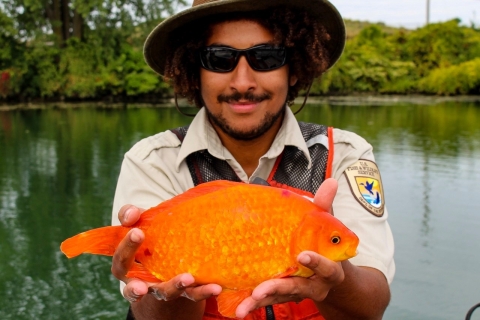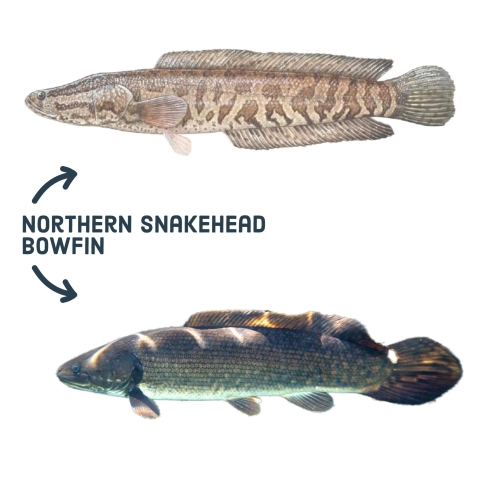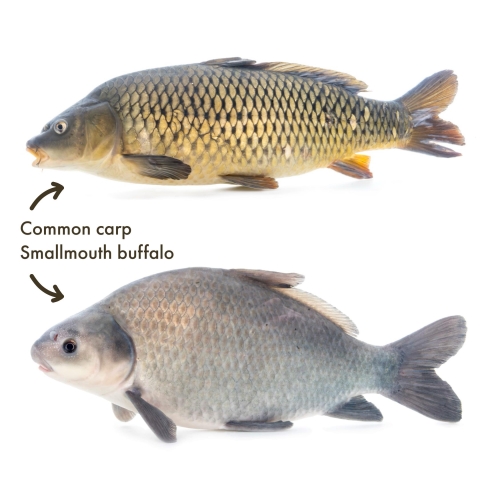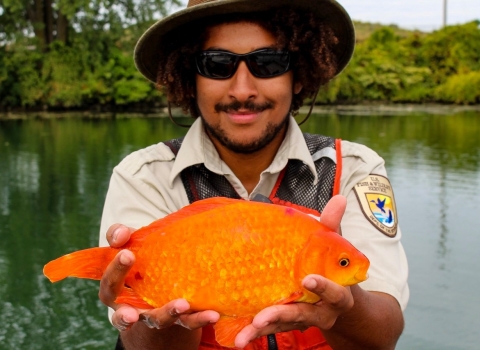Invasive species cause tremendous harm to our environment, our economy, and our health. They can drive out and eat native plants and wildlife, spread diseases, and damage infrastructure. Unfortunately, many of our lakes and rivers are already infested with invasive species invasive species
An invasive species is any plant or animal that has spread or been introduced into a new area where they are, or could, cause harm to the environment, economy, or human, animal, or plant health. Their unwelcome presence can destroy ecosystems and cost millions of dollars.
Learn more about invasive species like zebra mussels, silver carp, snakehead, and even goldfish. Before you hit the water, look up what invasive species might be present or contact your local state natural resource agency to find out.
What do you do if you see or catch an invasive fish?
Don’t put it back in the water or even your live well. Invasive species don’t belong in our waterways and shouldn’t be returned or transported anywhere.
In some states it is illegal to possess or transport invasive species of concern, so your best bet is simply to dispatch the animal quickly and humanely. Some invasive species like snakehead, blue catfish, lionfish, and carp are delicious and can be enjoyed for dinner.
Report new sightings whenever possible. Note the exact location and take a photo if you can. Report the sighting or catch to the appropriate authorities or use the USGS Sighting Report Form.
Don’t Let It Loose
Many people think that letting their goldfish or other aquarium fish loose into a local pond or river is a harmless and humane way to get rid of them. But that’s not the case. When goldfish are released into local waterways they become an invasive species that can live for up to 25 years and do real harm to the water quality and wild fish communities. Check out Habitattitude U.S. and Don’t Let it Loose for more information on how to be an environmentally responsible aquatic pet parent.
Watch out for these look-alikes!
Some invasive species look similar to native fish, so be sure you know how to spot the differences.
Bowfin vs Northern Snakehead
Northern Snakehead – An invasive species native to Asia that is primarily found in the mid-Atlantic.
- Striking python-like patterns on their body
- Scales on top of heard
- Long anal fin
- Pelvic fins close to the pectoral fins and gills
Bowfin – A long-lived and ancient species of fish found throughout the eastern United States.
- Little to no pattern on the scales
- No scales on top of head
- Short anal fin
- Pelvic fins set back from gills and pectoral fins
https://www.fws.gov/story/snakehead-dilemma
Buffalo vs Carp
Common Carp
Carp are members of the minnow family. Although several species of carp can be found in North America, none of them are native, and several are causing tremendous damage to native fisheries. Bighead carp, black carp, grass carp, and silver carp are collectively known as invasive carp.
- Gold or copper coloring
- Barbels (aka whiskers) found on the mouth
Smallmouth Buffalo
Buffalo are members of the sucker family. There are three species of buffalo fish that are native to North America: bigmouth, smallmouth, and black. These gentle giants are filter feeders can live over 100 years and weigh up to 80 pounds!
- Dark grey / black body with silver or white belly
- No barbels
- Long sickle shaped dorsal fin








